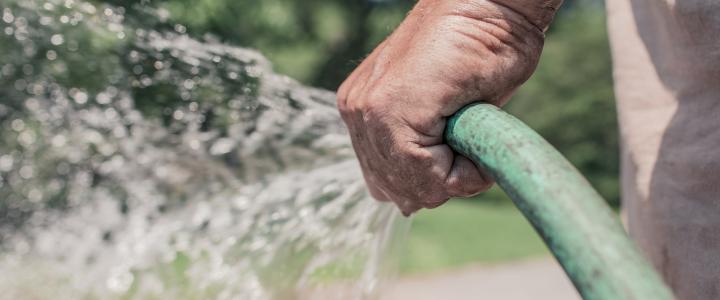
July 2020: When in Drought, Curb Your Water Use
A drought occurs when a region experiences below-average precipitation over an extended period of time, resulting in low stream flows and low surface water and groundwater levels. Because New Hampshire appears water rich in comparison to many other regions of the United States, people mistakenly think the occurrence of drought is a rare event. In actuality, New Hampshire experiences drought quite frequently. For example, between the years 2000 and 2020, drought conditions occurred within 11 of those 20 years. During the majority of these instances, drought conditions came and went quickly with minimal impact felt. In other instances, such as the 2001-2003 drought or the 2016 drought, conditions intensified to the point where hundreds of wells went dry and agriculture operations struggled.
How can this be when New Hampshire receives so much precipitation and there are lakes, ponds and rivers around every corner? The state’s watersheds and reservoirs are small and groundwater is held mostly in narrow bedrock fractures, which limits the state’s water storage capacity leaving the state more susceptible to drought conditions. Also, a timely snowmelt of a thick snowpack and early spring showers feed water supplies. If we don’t get those, the window of opportunity to replenish surface water supplies and recharge groundwater levels narrows. If the precipitation deficit continues, groundwater levels and average stream flows will fall much below normal, and the state will experience hydrological drought.
As water is a finite resource, to ensure the community’s essential and critical needs continue to be met during a drought, demand must be reduced. When droughts occur, many public water suppliers and towns implement outdoor water use restrictions for the purposes of curbing outdoor residential outdoor water use, which is one of the most effective ways to sustain water supplies during drought. Most outdoor use is nonessential and there is a significant amount to be saved. Outside of energy production, residential water use is the largest consumptive water use in New Hampshire and residential water use increases on average by 30% to 50% in the warmer months due to outdoor water use. In areas where lawn watering is intensive, summer use can increase by 100% to 300%.
While restricted outdoor use activities imposed may vary by water supplier or town, everybody has a part to play in protecting water supplies for their community. Below is guidance on what actions to take during drought to protect your utilities’ water supplies and your neighbor’s well:
- Stop watering lawns. A brown dry lawn means the lawn has gone dormant, as lawns do at the end of each growing season. A dormant lawn is conserving its resources. It will green up once more precipitation is received.
- Raise your lawn mower blade height to three inches. Longer grass blades retain moisture better, keep weeds to a minimum, and encourage roots to grow deeper and stronger.
- Mulch the lawn with grass clippings, rather than bagging them. The clippings will serve as nutrients and will help retain moisture.
- Water vegetable gardens by hand as early in the morning as possible, when evaporation rates are low. Check soil moisture depth by sticking your finger 3” to 4” down into the soil. If you have watered enough, your finger should come away damp with only a bit of soil stuck to your finger.
- For those on residential wells, spread out the timing of water use so that multiple water uses do not co-occur and so the well has time to replenish between uses.
- Conserve water by cutting back on shower times, only doing full loads of laundry when necessary, and turning off the faucet while brushing teeth, doing dishes and washing hands.
- Replace old water fixtures and appliances that are wasting water. Top-loading washing machines built before 2003 and toilets older than 1994 are known to be the largest water-wasting culprits in the home. Showerheads older than 1994 can also waste a great deal of water, as can older bathroom sink aerators. Selecting ENERGY STAR® certified machines and replacing old water fixtures with EPA WaterSense certified fixtures is an easy way to ensure you are choosing products that will save water and perform.
- Fix leaks, including running toilets. Running toilets can waste hundreds of gallons a day. Old and worn toilet flappers are often the culprit and are very easy to replace. Also, some toilet leaks can’t be heard. Check for a leak by dropping food coloring (12 drops) or a leak detector dye tablet in the toilet tank. Do not flush for 15 or 20 minutes. If the dye shows up in the bowl, you know that your toilet is running.
To stay informed on the latest drought conditions and current drought-related information, visit the NHDES Drought Management Program webpage.
This GREENWorks article can be also be found in our document library.




